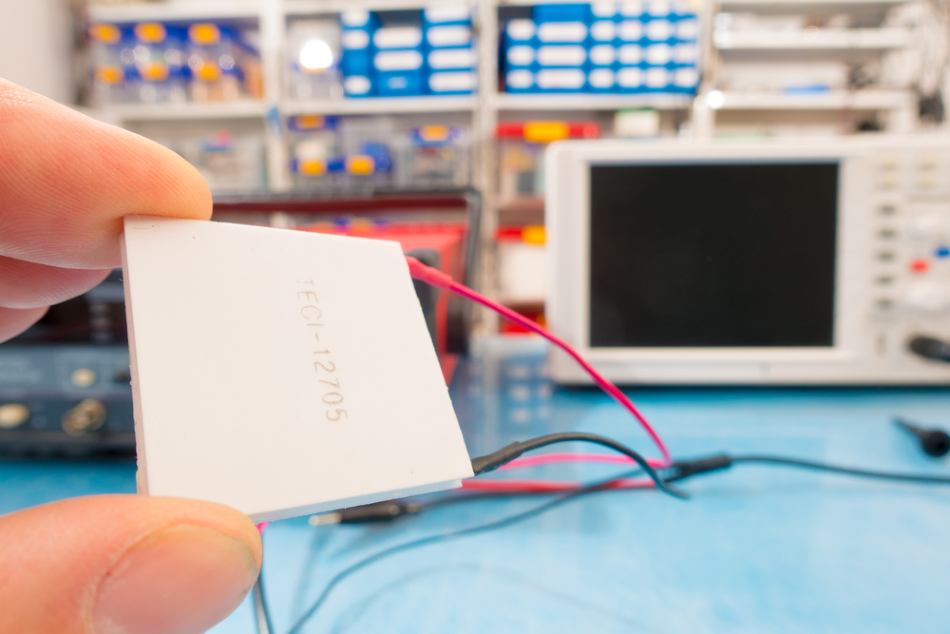
Image Credit: science photo / Shutterstock.com
If a device is small enough to be powered, with corresponding small energy demands, there is the possibility of providing it with energy without the use of batteries and wires via what would ordinarily be considered ‘waste energy’ — heat.
Research into the generation of electricity from heat — thermoelectric generation — has so far centered around the Seebeck effect, a significantly limited phenomenon that allows the build-up of an electric potential across a temperature gradient.
Alternative new research from the University of Tokyo Institute for Solid State Physics and Department of Physics, published in the journal Nature, suggests employing a less well-known phenomenon to perform the same task, the Anomalous Nernst Effect (ANE).
The team’s research is founded upon the use of a mostly iron-based material thin enough to be molded into various forms. The beauty of a thermoelectric generator made from this material is the element’s non-toxic nature, cheapness, and abundance.
In the Nature paper, the team from the University of Tokyo led by Research Associate Akito Sakai, and Professor Ryotaro Arita, discuss the use of a process called ‘doping’ — the intentional addition of impurities to a semiconductor to adjust its electrical, optical, or structural properties — to create a material that is 75% iron, and 25% aluminum or gallium.
The flexible film-like material has applicability to devices with small energy requirements, such as wearable technology and remote sensors. Wearable remote sensors are currently a heavily researched area of technology due to the advantages they provide in medical science, both for clinical trials and the treatment of patients.
The company MC10 is just one of a wide range of biotech suppliers marketing products that would greatly benefit from the use of thin thermoelectric generators. The company’s BioStamp Research Connect system — one of the first wearable bioelectric tattoos — collects physiological information such as vital signs, posture, and activity from a patient and delivers it to doctors and researchers via a cloud-based storage software.
Conducting clinical studies with wearable or remote biosensors and mobile health platforms enables researchers to obtain a detailed, real-world understanding of the patient’s physiology, behavior, and response to treatment. Thinner, more flexible thermoelectric generators could serve to make this technology more discrete and less-intrusive, allowing researchers to obtain a more accurate picture of a patient’s behavior.
A cheaper material reducing overall production costs would, in turn, make wider studies more feasible for clinical trials, as well as allowing doctors to remotely monitor more patients than ever before.
Making the Anomalous Nernst Effect a Viable Energy Source
This is not the first time that the team from the University of Tokyo has experimented with ANE-based generators. The materials previously used have been difficult to source and are prohibitively expensive.
The team has been aware for some time that to reap the benefits of an ANE-based generator — namely large-area and flexible coverage of a heat-source — significant improvements to the system had to be made in both the material’s performance and its safety and stability.
The researchers say that the use of iron-based film-like material significantly boosts the effectiveness of ANE, producing an astounding twenty-time increase in the voltage perpendicular to the direction of a temperature gradient across the surface of the material.
The result is thin and more flexible materials that harvest energy rather than relying on heavy and chunky batteries. The resultant generators are also more efficient at energy harvest than generators based upon the Seeback effect. This could potentially result in thermoelectric technology supplying power to devices in locations and with applications where a battery would be deeply impractical.
The ANE effect arises from what is known as the Berry curvature of the electrons near to a value of energy referred to as the Fermi energy. The team used computer simulations to design a large Berry curvature which pointed them to the right doping concentrations for the ideal material for their requirements.
The team’s research has mostly focused on computer simulations and numerical calculations, which reduced the need for time-consuming and expensive repeated experimentation.
Click here for more information on nanotechnology equipment.
The advantage of using computer simulations is that it allows the researchers to switch between various materials and compositions to find the best mix for their needs. They were also able to significantly cut down the amount of time that materials scientists would usually spend analyzing electronic structures called nodal webs by starting from the first principles established by quantum mechanics.
Essentially this means that the material created by the team is not the only revolutionary aspect of the team’s research — the numerical methods and computational techniques they have pioneered replace previous methods that have been prohibitively difficult to undertake. Thus, the team has developed a framework that can be used by other scientists to develop materials specially adapted to specific requirements.
References and Further Reading
Sakai, A., Minami, S., Koretsune, T., et al., [2020], ‘Iron-based binary ferromagnets for transverse thermoelectric conversion,’ Nature, [https://www.nature.com/articles/s41586-020-2230-z].
Kalali, A., Richerson, S., Ouzunova, E., et al., [2019], ‘Digital Biomarkers in Clinical Drug Development,’ Handbook of Behavioral Neuroscience, Volume 29, Pages 229–238, [https://doi.org/10.1016/B978-0-12-803161-2.00016-3].
Disclaimer: The views expressed here are those of the author expressed in their private capacity and do not necessarily represent the views of AZoM.com Limited T/A AZoNetwork the owner and operator of this website. This disclaimer forms part of the Terms and conditions of use of this website.